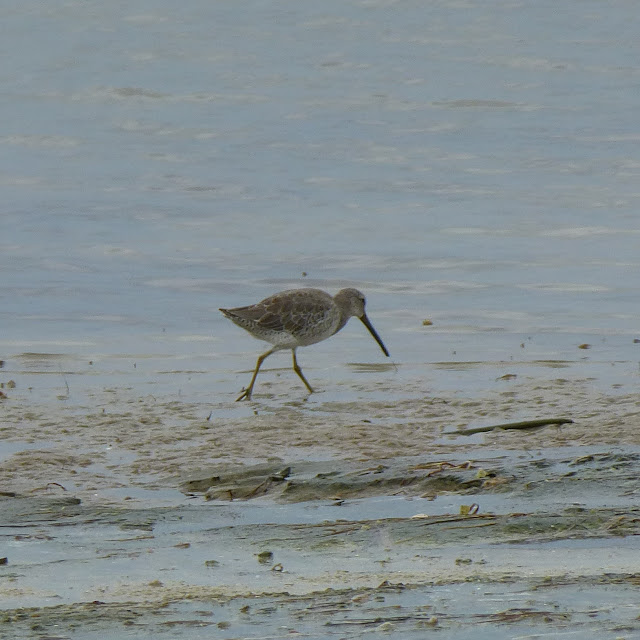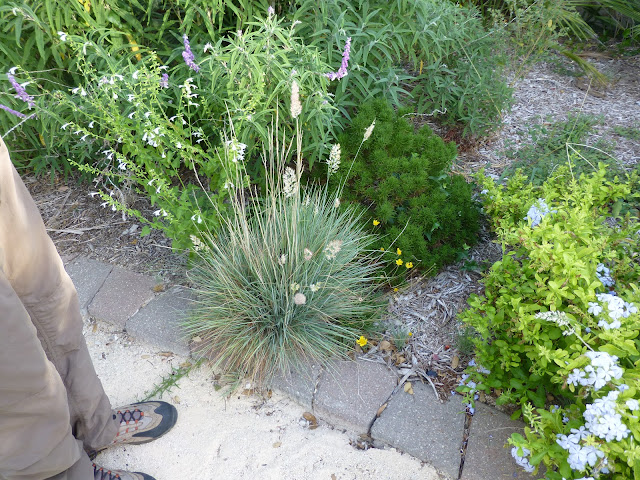I apologize for the time it's taken for me to report on this trip. But you know about the "best laid plans" and all those other homilies.......
Several weekends ago, Sept. 6 - 9, 2012 to be exact, Avie attended the Southern Sleep Conference at St. Pete Beach, FL, kindly taking me along. In addition to visiting with some old friends who had moved to the area years ago, I also took the opportunity to do a bit of birding on Florida's Gulf Coast.
Happily, it was during fall migration. Even better, the St. Pete Beach Audubon Society was having a field trip to John Chesnut Sr. Park. Located on the southeast corner of Lake Tarpon it is reputed to be a great migrant "trap". So, I hopped into our rental car and set out to join them.
Right out of the car, in the parking lot, there were Warblers galore. Unfortunately, the time spent in an air conditioned car caused my binoculars to fog up when I got out into Florida's humid weather. So, while everyone else was counting the Warblers, I was listening and straining with eyes naked.
The field trip took us to a couple of different parking lots, chasing mixed flocks. The most common birds were Blackburnian and Yellow-throated Warbler. Of course, being Warblers, an my being more a birder than a photographer, I enjoyed seeing them and didn't make an attempt to photograph these ever-moving little birds.
However, a bit later in the trip, we took a trail where there were a couple of cooperative birds. One was an Eastern Wood-Peewee, perched in clear view.
But I'd have to say the best photo op and tied with a Prothonotary Warbler for best bird of the day was this cooperative Barred Owl. It sat very still, but refused to turn its head so I could get its face in the photos I took. No matter -- any birding day with an owl is a good birding day.
Shame on me for not saving my bird list from this day. But I will say, in spite of a lengthy downpour which limited our available time in the field, it was a worthwhile fall migration spot if you find yourself in the area.
Avie's conference ended on Saturday afternoon. So, Sunday morning we packed up, checked out of our hotel, and headed down to Fort DeSoto Park for a full morning of birding. It was raining when we drove down and it rained for a couple of hours after we got into the park. It put a little bit of a damper on things. But, dammit, we're birders! So we persevered.
Of course, most of the birds continued on in spite of the rain, as demonstrated by this Great Blue Heron, perusing the puddles in one of the parking lots for frogs.
On a stop into the ladies' room, I picked the lucky stall and saw this large Cuban Tree Frog literally hanging around. Since the restroom was deserted, I called Avie in and asked him to put his finger in the frame of the photo for size perspective. The frog didn't even balk.
As you know, birders are a friendly group of folk. While we were looking up into some pine trees, a car pulled over and asked if we had "seen anything good". We pointed out a Pine Warbler. The gentleman in the car recommended we go over to the "Ranger's House" and walk around the fence along the trail to the big tree in the back. We took his advice and saw the best mixed flock of the day.
Again, Blackburnian and Yellow-throated Warblers were the most common birds. But we were also greeted with many other migratory songbirds. Additionally, there was an amazing migration of Common Nighthawks overhead, with thousands flying in a never-ending stream.
A Cuban Anole sat on a nearby tree, sunning.
On our way out of the park we stopped at an area which was supposed to be good for shorebirds (GROAN!). We fought against working with these tricky birds for over twenty-five years. But we've decided, with our new 80mm Swarovski Scope, it's about time we try to tackle them. Tackle them we did -- juvenile/fall plumage and all.
So, what follows are our best attempts at identification. If you find any issues, please let me know in the comments.
Here's a non-breeding Willet:
Short-billed Dowitcher:
Dunlin:
Too much obstructive greenery for many of them. But there's a lovely "coming into plumage" Black-bellied Plover to the right.
Just a nice shot of a Great Egret behind a Black-bellied Plover:
Okay -- My brain is starting to hurt, so I'll let you identify the rest. I will tell you these are the shorebirds we know we saw:
Black-bellied Plover
Semipalmated Plover
Killdeer
Spotted Sandpiper
Lesser Yellowlegs
Willet
Marbled Godwit
Ruddy Turnstone
Sanderling
Western Sandpiper
Least Sandpiper
Dunlin
Short-billed Dowitcher
We also saw this Wood Stork, looking very much like a coquettish dancer in the water.
I'm not sure when we'll be returning to the Gulf Coast area of Florida. But, compared to our subsequent weekend on the Atlantic Coast, I would say fall birding is far superior on the West side of the peninsula!
























































